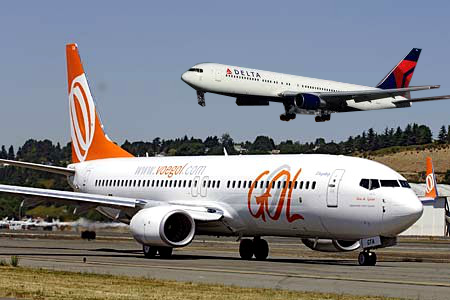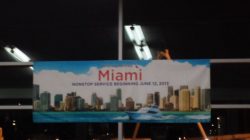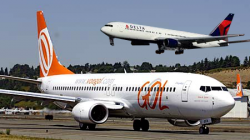Earlier today, American Airlines announced a new codeshare agreement with GOL (Brazil’s second largest airline) and increased frequencies on seven routes from its hub at Miami. The codeshare agreement with GOL covers 53 GOL flights and 20 new destinations across South America. After approval from US and Brazilian authorities, GOL’s code will also be placed on American flights within the US. the move was widely expected after American’s longtime South American partner LATAM defected into the arms of Delta Air Lines last September.
The new flying from Miami includes a second daily flight to Rio de Janeiro during peak winter months, flown on a Boeing 787-8 (the current daily flight is operated by a Boeing 777-200ER). American will also add 12 additional year-round domestic frequencies at Miami:
- five extra flights per day to Orlando (up to 12x daily)
- two extra flights per day to Raleigh-Durham (up to 7x daily)
- two extra flights per day to Tampa (up to 8x daily)
- one extra flight per day to Boston (up to 8x daily)
- one extra flight per day to Nashville (up to 3x daily)
- one extra flight per day to Houston (up to 6x daily)
GOL codeshare was expected but likely will have a low impact
While American had to do something to respond to Delta’s coup, it’s no accident that a partnership with GOL was readily available. Prior to purchasing 20% of LATAM, Delta actually owned a 9% stake in GOL. But the payoff for Delta was relatively minimal. GOL primarily offers coverage of domestic destinations within Brazil, which offers limited utility for other South American routes like Buenos Aires or Santiago. Moreover, US outbound demand to Brazil is overwhelmingly directed to Sao Paulo and Rio de Janeiro, which are already well served by US carriers. So Gol’s Brazilian domestic network provides very little incremental feed.
The one exception to that rule is Miami, which has ample demand to Brasilia, Salvador, Recife, Belem, Belo Horizonte, Porto Alegre, and Fortaleza. GOL does have nonstop service from Fortaleza to Miami, but all of the other destinations will be well within the range of American’s A321XLRs when they are delivered. Brazilian outbound demand from secondary cities is also centered on Miami and (to a lesser extent Orlando), but again those destinations would have the same potential boost from American adding nonstop service. Ultimately, the codeshare has some PR value but the incremental business impact is probably less than $10-15 million per year – a drop in the bucket for American.
American pushes back against Delta in Miami
The additions in Miami are a lot more interesting, as they come in the wake of Delta’s first foray into point-to-point flying in Miami. Late last month, Delta announced 13 new daily flights this summer from Miami to Orlando (5x daily), Raleigh-Durham (2x daily), Salt Lake City (1x daily), and Tampa (5x daily). Tampa and Orlando are important destinations for South American travelers and key feeders into American’s South American hub in Miami.
With its own frequency growth, American is directly hitting back at Delta. Orlando, Tampa, and Raleigh-Durham were all announced last month, Boston is a Delta hub, and Nashville is a named Delta focus city (albeit one without much point-to-point flying from Delta). Houston doesn’t have an immediate tie to Delta, but it is one of the ten biggest US-originating markets for South American travel. The importance of feed from other US destinations has increased for American in a post-LATAM world, and Houston (along with Chicago, Los Angeles, San Francisco, and Dallas) is one of a few large spokes that Delta could conceivably add for feed in the Miami market.
On the international side, Rio is an interesting market to grow in given that tourism demand from the US is wobbly and the oil market (Rio’s primary source of business traffic) is in rough shape. However, the additions fit the general pattern from American of bulking up at key LATAM hubs and markets. In November, American added a third daily flight from Miami to Lima and Sao Paulo, and a second daily flight to Santiago, Chile. It will be interesting to see if American follows suit in Colombia (Bogota), Ecuador (Quito/Guayaquil), or Argentina (Buenos Aires).





